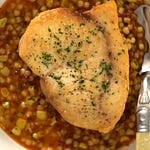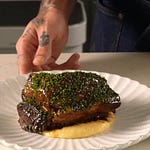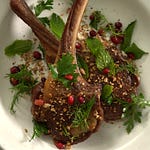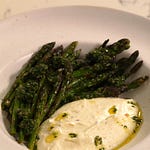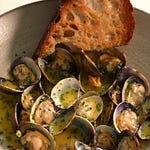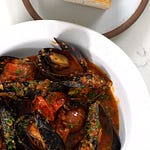Cherry puree
1/2 lb pitted fresh cherries
3/4 cup red wine
3/4 cup cherry juice
1 star anise pod
1 clove
3 black peppercorns
1/4 tsp malic acid (optional)
salt to taste
Place the cherries in a small pot and add the wine, juice, star anise, clove, and black peppercorns.
Place the pot on the stove over medium low heat and bring to a simmer. Simmer for 15 minutes or until the cherries are soft.
Strain the cherries through a fine mesh sieve and remove the spices. Reserve the cherry reduction for the sauce later.
Blend the cherries completely smooth, you shouldn’t have to add any liquid. However if you’re having any trouble, you can add a splash of cherry reduction to get it to spin.
Season to taste with salt and optionally malic acid. Malic acid is the primary acid found in cherries so it just makes the puree taste sharper.
Store in the fridge and I brought it to room temperature for serving.
Duck and cherry sauce
2 quarts duck or chicken stock
3/4 cup cherry reduction (from above)
4 cloves smashed garlic
5 shallots thinly sliced
1 fresh bay leaf
5 black peppercorns
small knob butter
salt
Warm up your stock and have it ready nearby.
Preheat a pot over medium low heat and add a few tbsp of oil. Add the smashed garlic and toast on all sides until golden. Add the shallots and saute until the shallots begin to look translucent, around 4 minutes.
Deglaze with 1/2 cup of the cherry reduction and reduce this liquid until it’s syrupy and thick. Around 2 minutes.
Add the duck stock, bay, and peppercorns. Bring to a simmer.
I like to move my pot slightly off center from the burner at this point so all of the bubbles push any fat or impurities to one side, making it easier to skim. I also keep a rubber spatula nearby to clean the sides of the pot. All that sticky goodness on the sides tastes good, work it back into your sauce before it burns.
Simmer for 40-50 minutes or until the liquid has noticeably started to thicken. Skimming and cleaning the sides of the pot every now and then.
Strain into a smaller pot and finish reducing it in there. As it starts to thicken it will cling to the veggies and aromatics and you lose a bit.
Once your sauce is nappe or coats a spoon, whisk in a touch of cold butter and season to taste with salt.
This is where you can use any leftover cherry reduction to adjust the acidity.
Hold warm for serving or cool completely in an ice bath. To reheat, place in a small pot over low heat and adjust the consistency with a touch of unreduced stock.
Duck breast
duck breast- however many you wish
The day before you plan on cooking it, place it skin side up in the fridge. Uncovered. The skin will air dry and tighten up, making it easier to score or use a jaccard. The dry skin will also prevent sticking in the pan later.
When you’re ready to cook the duck, pull it from the fridge and score the skin with a very sharp knife or use a jaccard. Careful not to puncture all the way through and hit the meat with either method. It is easier to do this while the skin is cold, right out of the fridge. Now you can leave it on the counter for an hour to come closer to room temperature.
Season the meat side only with salt and any seasonings you wish. Place the duck, skin side down in a cold pan. Turn the heat to medium low.
You want to hear sizzling the whole time but you shouldn’t see any smoke. After around 6 minutes your skin should be nice and golden brown. I like to start basting the duck with all of the hot rendered duck fat for a couple minutes. Flip the duck and cook it on the meat side for 2 minutes.
For medium, cook to 130f and then after a ten minute rest it should be closer to 140f.



